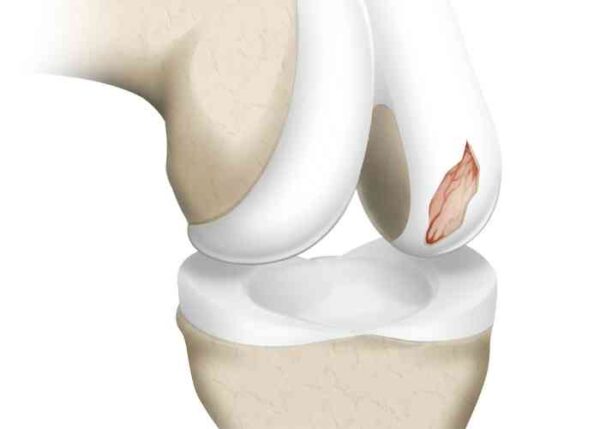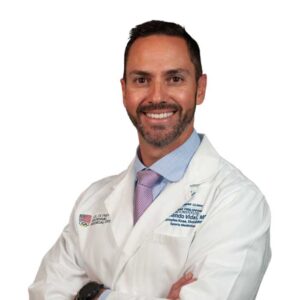What is articular cartilage?
Articular cartilage is the smooth, white tissue that covers the ends of the bones, where they come together to form a joint. This highly specialized and complex tissue allows for a pain free, smooth and fluid motion of the joint. Cartilage is critically important in the joint and when damaged, can cause pain and swelling during activities. Articular cartilage can be injured by trauma or normal wear and tear. If the damage is severe it can lead to a complete loss of cartilage, causing bone to rub on bone. This can lead to a condition known as osteoarthritis.
Cartilage is one of the most highly specialized tissues in the body and as a result has very limited intrinsic healing capacity. Furthermore, injury to articular cartilage rarely occurs in isolation. Oftentimes patients have co-existing pathology such as malalignment (bow legged or knock-kneed), meniscal tears or insufficiency, and/or knee instability. Successful management of these injuries requires an understanding of how all of these factors interplay (see section on joint preservation) and the ability to address them when indicated. Decision making is complex and is the key to success. Articular cartilage injury in a young patient remains one of the most difficult issues that we as Orthopedic Surgeons face and choosing a provider with experience in these conditions is key. Versatility with a variety of cartilage repair techniques and expertise with complex procedures such as osteotomy is the driver of a successful outcome. Dr. Armando Vidal, complex knee surgeon, is highly experienced at a variety of knee cartilage treatments and restorations for patients in Vail, Aspen and the surrounding Denver, Colorado communities.

What are the symptoms of a damaged or torn knee cartilage?
There are two types of cartilage in the knee; articular cartilage and the meniscus. Both types of cartilage protect the bones of the leg and help them to move and function smoothly and painlessly. The articular cartilage is attached to the bone, where the meniscus is set between the bones and acts as a shock absorber. If there is damage to the articular cartilage, arthritis can result. Symptoms of damaged articular cartilage are:
- Joint pain that continues, even when at rest. Pain may worsen when standing or putting weight on the joint.
- Swelling – Not always visible, especially during the early stages of articular cartilage damage.
- Stiffness – Trouble bending and straightening the knee easily. The knee may lock or catch easily.
- Grinding sensation – Sometimes called crepitus, patients may hear popping or grinding in the joint.
How is cartilage damage diagnosed?
Cartilage damage is diagnosed by a thorough history, physical exam and imaging – including x-rays and MRI. For Patients in Vail, Aspen and the surrounding Denver, Colorado communities, Dr. Vidal will assess the cartilage damage and identify any abnormalities or defects.
Do cartilage injuries always need surgery?
Thankfully, not all cartilage injury needs surgery. In fact, many elite level athletes have cartilage injury and don’t even know it! Dr. Vidal is conservative by nature and understands that an athlete can co-exist with a cartilage injury and still have a successful career. Non athletes can also continue daily activities and participate in sporting events with a cartilage injury.
The decision to have cartilage surgery is affected by several different factors, including but not limited to: lesion characteristics (size, bone involvement, location, overall status of the joint), current level of symptoms, impact on life and career, seasonal pressures for return to play, long term goals, and ability to commit to the necessary postoperative rehab. There are several options for non-operative management including:
- Skillful neglect (observation)
- RICE
- Biologic treatment (PRP, Stem Cell…)
- Viscosupplementation
- Bracing
- Physical Therapy
“OK…I’ve tried all of the non-operative options and still need cartilage surgery. How can the articular cartilage be repaired or restored?”
For many patients their symptomatic cartilage lesions ultimately require surgery. Cartilage repair is not “one size fits all”. In fact, customizing a solution for a patient may seem easy but is highly technical and personal. Dr. Vidal can use a variety of different techniques of repair, depending on the size, depth and location of the damaged knee cartilage. Other factors influence decision making and the need for concomitant procedures (see section on joint preservation).
What is a focal cartilage defect?
As the name suggests, the term “focal” refers to an isolated place or area in which the cartilage is damaged. Typically, this term is reserved for a localized area of cartilage damage in an otherwise healthy knee. Focal cartilage damage can be seen as degenerated or damaged cartilage on what was once a normal joint surface. These areas of deteriorated cartilage can lead to pain, swelling, stiffness and decreased mobility and knee function.
What is knee cartilage repair or restoration?
Cartilage repair or restoration refers to the techniques used to restore or replace cartilage to an area that is damaged. These techniques can take many forms:
Chondroplasty: Chondroplasty is the simplest of the surgical cartilage treatment options. Although not technically a “repair”, chondroplasty serves a very important role in the treatment pathway for cartilage injuries. During this arthroscopic procedure, Dr. Vidal debrides (trims away) the damaged area of cartilage. This treatment smooths out the area and helps to reduce pain, swelling and mechanical symptoms. Frequently, chondroplasty serves as the first step in a more complicated cartilage treatment. This procedure serves a very important diagnostic and therapeutic role. In some cases, this is all that is needed to achieve the desired outcome. In others, it allows Dr. Vidal to better assess the lesion, the context in which it occurs, stage its severity and size, and help formalize a personalized treatment strategy. Additionally, during this procedure cells can be harvested for a MACI procedure if that is determined to be the right option for your lesion (see below).
Augmented Microfracture: This treatment is best described by comparing it to road treatment for potholes. Used when the cartilage damage in the knee appears to be gouged out or have a divot, microfracture surgery fills in the “pothole.” This is done by Dr. Vidal making small holes in the defective area’s bony surface, causing it to “bleed.” The bone sends out marrow and stem cells to form a clot over the defective area as a response to heal the small microfractures. The result is a covering of fibrocartilage which fills in the damaged areas of the cartilage. Modern modifications of this technique enhance the biology and the quality of the repair tissue by using scaffolds that encourage the marrow and stem cells to differentiate into cartilage cells (chondrocytes) rather than scar tissue.
Allograft OATs: Osteochondral allograft transfer (often referred to as allograft OATs) is often called the “gold standard” for cartilage repair. In an allograft OATs procedure, a plug of living, viable cartilage and bone is harvested from a donor to repair a focal chondral lesion. The donor tissue is size-matched to an individual patient and surgically prepared to precisely reconstruct a lesion. This technique is very versatile and can allow for reconstruction of large and irregular lesions. The greatest benefit of this technique is that it is a true hyaline cartilage repair strategy that is actual cartilage from day one! Think of the difference between laying sod and planting seeds for an area on your lawn that is missing grass. Keep in mind, however that despite its versatility, it may or may not be the best option for your lesion.
Matrix Associated Chondrocyte Implantation (MACI): MACI is a two-stage procedure where a biopsy of healthy cartilage is first removed from the knee (during the chondroplasty step) and cultured in a specialized lab in Boston. These cultured autologous (your own) chondrocytes are then embedded on a specialized collagen membrane and used to patch an area of cartilage damage. This technique is also very versatile and allows for the repair of even very large lesions with your own cells. Dr. Vidal has extensive and successful experience with MACI, whereas very few other surgeons have experience with this technique or perform it with much frequency. It is important to ask your provider about their personal experience with MACI, especially in the Vail, Aspen and surrounding Denver Colorado communities.
Novel Procedures: Cartilage repair and restoration is still in its infancy compared to many other orthopedic procedures. There are several novel techniques that are being developed. Dr. Vidal is committed to innovation and advancing the science of cartilage repair. As such, he is involved in several FDA trials looking at novel scaffolds that may hold the future of repair of these lesions. Feel free to ask Dr. Vidal at your consultation if you may be a candidate for enrollment in one of these trials.
What is the Recovery and Rehabilitation like after Joint Preservation for Osteoarthritis?
It is important to remember that joint preservation procedures are highly successful when patients are appropriately selected. Not every patient is eligible for cartilage repair and restoration and decision making is key. Recovery can be a long but worthwhile investment. Adherence to the postoperative rehabilitation protocol is as critical to your success as the surgery itself and Dr. Vidal will ensure that you are paired with an experienced therapist who can optimize your outcome. Many of these procedures can require long (6-8 weeks) periods of non-weightbearing and full recovery can take as long as a year depending on the complexity of the issue. Dr. Vidal is fond of saying that this is a “marriage” and he and his team are committed to successfully and safely seeing you through the involved and nuanced recovery that these procedures demand.
Articular Cartilage Surgeon
Articular Cartilage helps to protect the knee joint and allows for the smooth movement of the bones in the leg. This cartilage can be damaged in a number of ways, especially in athletes. Complex knee surgeon Doctor Armando Vidal has created successful treatment plans for patients in Vail, Aspen, and the surrounding Denver, Colorado communities to treat damage to their articular cartilage. If you are experiencing knee pain, contact Dr. Vidal’s team today!

Locations
180 S Frontage Rd W
Vail, CO 81657
226 Lusher Court
Ste 101
Frisco, CO 80443
322 Beard Creek Road
Edwards, CO 81632


